Contents
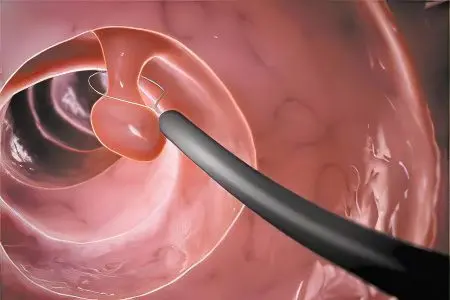
Polyps are abnormal benign neoplasms of a round, teardrop-shaped or irregular shape that are localized on the walls of hollow organs and protrude into their lumen. They are mounted on a wide base, or have a leg. Such growths can appear on the inner surface of any organs of the body that have a mucous membrane.
The most common polyps are found in the following places:
Intestines;
Stomach;
Uterus;
gallbladder;
Bladder;
Nasal cavity.
By themselves, these neoplasms are not terrible, but sometimes they turn into malignant tumors. If a person does not have any alarming symptoms, this does not mean at all that in the future the polyp will not degenerate into a tumor. This is why, whether or not polyps cause discomfort, they must be treated conservatively or surgically removed.
Polyps in the uterus
Polyps in the uterus are often diagnosed benign growths of the mucous membrane, which are usually caused by serious hormonal disorders. They also appear against the background of a variety of inflammatory processes in the pelvic organs, for example, cervicitis or cervical erosion. In addition, polyps often coexist with endometriosis. Postmenstrual bleeding is considered the main symptom of such growths. The signs of polyps include abundant uterine menstruation, or vice versa, scanty irregular periods, as well as vaginal bleeding during menopause. However, such a pathology is sometimes observed in the normal menstrual cycle. Many patients complain of increasing pain during sexual intercourse. It also happens that no symptoms indicate polyps in the uterus.
For a complete diagnosis of uterine polyposis ultrasound examination, metrography and the most informative method – hysteroscopy are used. Thanks to such modern procedures, the gynecologist can easily assess the general condition of the polyp, determine its exact location and size. If the growths appear against the background of inflammation, then it is enough to cure the source of infection so that the polyps disappear without intervention. With the help of a hysteroscope, serious operations can be performed to remove large growths, while complications will be minimal.
Treatment of polyps in the uterus most often performed surgically, which involves curettage. Sometimes doctors also use non-surgical treatment by administering modern progesterone preparations. Hormones contribute to the rapid drying of growths. However, it should be mentioned that with a conservative method, the risk of re-formation of polyps is very high.
Polyps in the nose
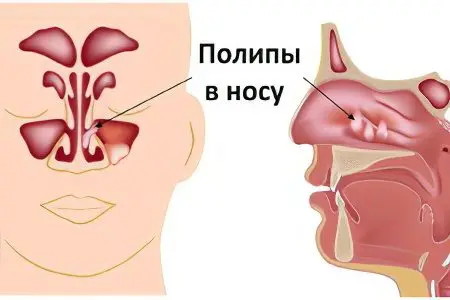
Benign neoplasms such as nasal polyps are most common in children under 10 years of age. Nasal polyposis is the same as adenoids. However, such a pathology can also manifest itself in adults due to the strong growth of the mucous membrane of the pharyngeal tonsils. It is this fabric that is designed to protect the human body from all kinds of bacteria and viruses.
The main reasons for the formation of polyps in the nose are as follows:
Repeatedly transferred infectious diseases of the ENT organs;
Prolonged lack of fresh air or systematic inhalation of harmful substances;
Malnutrition and beriberi;
Allergy and chronic sinusitis.
Common symptoms of nasal polyps are also rashes on the skin around the nose, inflammation of the inner lining of the sinuses, difficulty breathing, sleep problems, traces of mucus on the pharyngeal wall, lack of taste, poor sense of smell, snoring and chronic sinusitis. Most patients with adenoids suffer from terrible headaches and a constant runny nose with severe nasal congestion. With small growths, signs may not appear. And conservative treatment of infectious diseases and allergic manifestations rarely leads to resorption of polyps in the nose.
Treatment of polyps in the nose surgical: usually doctors are inclined to the immediate surgical removal of such neoplasms. When polyps grow in large groups, standard endoscopic surgery is prescribed. To speed up healing, doctors recommend doing regular sinus lavage with sea salt. Carrying out preventive measures, the use of antiallergic drugs and specific immunotherapy can prevent re-growth.
Endometrial polyps
Polyposis of the endometrium of the uterus is a serious disease that can be characterized as the uncontrolled formation of multiple benign neoplasms. With such hyperplastic processes, the base endometrium grows, in other words, the entire inner layer of the uterus. This disease most often occurs in women aged 35 to 55 years. At an older age, after menopause, the incidence rate is low. The polyp of the uterine endometrium has a body and a leg. It is made up of epithelial cells. Growths come in different shapes, depending on their structure and structure.
Specialists divide uterine endometrial polyps into the following types:
Railway;
Glandular fibrous;
fibrous;
Adenomatous.
In women of early reproductive age, neoplasms of the glandular structure are usually observed. Whereas in patients of mature age, either fibrous or adenomatous polyps are diagnosed. It should be noted that glandular-fibrous growths are characteristic of any age category.
Possible causes of uterine endometrial polyposis include hormonal disorders, traumatization of the uterine cavity, prolonged contact of the mucous membrane with the intrauterine device, miscarriages and frequent abortions, childbirth with incomplete removal of the placenta, decreased immunity, endocrine disorders, extragenital diseases, psychological factors, as well as chronic inflammation of the small pelvis.
Symptoms of endometrial polyposis can be very diverse:
Menstrual irregularities;
Cramping pains in the lower abdomen;
White, yellowish or brown discharge from the genital tract;
intermenstrual bleeding;
Pain and bleeding during or after sexual intercourse;
Inability to conceive or miscarriage.
But quite often, such a pathology does not manifest itself in any way. Small growths can only be detected on an ultrasound scan, endometrial scraping or hysteroscopy.
The main treatment for uterine endometrial polyposis considered surgery. Under the control of a hysteroscope, a specialist removes polyps and carefully scrapes the uterine mucosa. Depending on the form of growth and the age of the patient, further treatment and postoperative recovery are prescribed. It should be mentioned that after curettage of glandular and glandular-fibrous neoplasms, obligatory hormonal treatment is indicated in order to regulate the menstrual cycle.
Polyps of the rectum
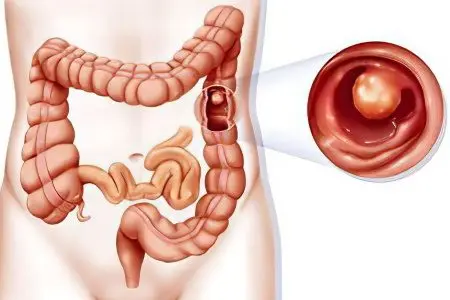
A rectal polyp is a benign glandular neoplasm that is attached to the rectal wall with the help of a leg. Growths often form in small groups. Such intestinal pathology occurs not only in adults, but also in children. With hereditary polyposis of the rectum, growths in most cases are prone to transition into a malignant form. According to modern medical research, middle-aged men suffer from this disease at least one and a half times more often than women. Early detection and treatment of these neoplasms allows you to count on a positive prognosis.
Numerous polyps of the rectum can be classified as follows:
In count – on single, multiple and diffuse;
By morphological structure – on glandular, villous, glandular-villous, juvenile, hyperplastic and fibrous.
Pseudopolyposis – can be distinguished into a separate group, this is when the mucous membrane grows as a result of chronic inflammation.
Possible causes of rectal polyps are chronic inflammation of the intestinal mucosa, stagnation of feces and microtrauma caused by frequent constipation. Along with this, the growth of polyps contributes to the adverse effects of the environmental situation, unhealthy diet, physical inactivity and alcohol abuse. You can also note the dependence of polyposis on diverticular disease and vascular pathologies. Modern experts do not exclude the genetic predisposition to intestinal polyposis.
The severity of symptoms of rectal polyps directly depends on the number, size, morphological structure, location and malignant nature of the growths. As a rule, such neoplasms are discovered incidentally during a full endoscopic examination of the intestine. Very large growths can be manifested by a feeling of discomfort, bloody discharge from the anus, a feeling of the presence of a foreign body in the rectum, as well as pain in the lower abdomen and iliac region. Serious violations of the peristaltic activity of the gastrointestinal tract often contribute to the occurrence of not only constipation, but also diarrhea.
Diagnosis of intestinal polyposis provides for regular examinations by a proctologist. Early detection will help prevent malignant growth and will guarantee successful removal of the tumor.
Treatment of polyps in the intestine surgical – since they are practically not subject to reduction by conservative methods, they are simply removed. Those polyps that are located low are operated transanally. In addition, small growths can be removed by electro-excision during a special endoscopic procedure. Very large growths are removed only in parts. After resection, all polyps should be subject to mandatory histological examination for malignancy.
Polyps in the gallbladder
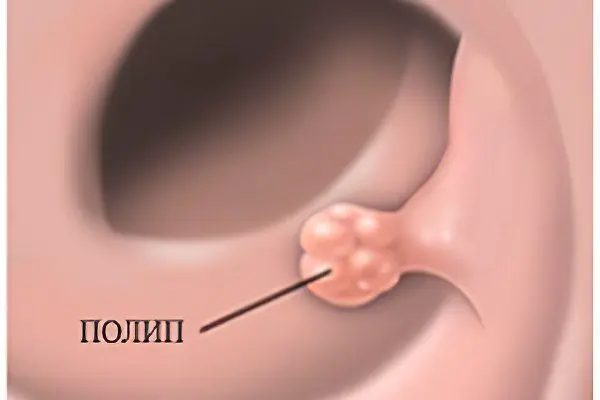
Growing polyps in the gallbladder are pathological neoplasms of a benign nature that appear on the mucous membrane. The growths themselves do not pose a danger to humans, but on average in 15% of cases they flow into malignant tumors without any symptoms.
The most common types of such pathology are:
Cholesterol polyposis;
Inflammatory polyposis;
Adenoma of the gallbladder;
Papilloma of the gallbladder.
Symptoms of bile polyps usually erased, patients have practically no complaints, except for discomfort in the right hypochondrium. In rare cases, there is intolerance to a certain type of food. Often, polyps in the human gallbladder are found absolutely by chance during an ultrasound examination. Endoscopic ultrasonography may be used to confirm the diagnosis.
Treatment of polyps in the gallbladder, according to modern doctors, it cannot be conservative, only surgical intervention is relevant. With extensive clinical manifestations, the entire gallbladder must be removed, regardless of the size of the existing polyps. If the growths in the gallbladder are larger than 1 cm in diameter, and there are several of them, then the organ should be removed immediately due to the risk of malignant degeneration.
After a control ultrasound examination, the doctor decides whether to remove small polyps. Pedunculated growths with a diameter of less than 9 mm should be monitored once every six months for two years. After this time, if the neoplasm has not increased in size, ultrasound is performed once a year. If the polyp grows, it must be operated on. A growth without a leg is under the control of a doctor once a quarter.
Standard surgery for resection of bile polyps is a laparoscopic cholecystectomy. Using a unique endoscopic technology, only growths can be removed, while maintaining a functioning gallbladder.
Polyps of the cervical canal
Special benign neoplasms – cervical canal polyps – mainly come from the columnar epithelium of the endocervix. The causes of these growths are not clear enough. As a rule, such a pathology is diagnosed in patients over the age of 35-37 years. Many experts believe that the development of cervical polyposis is based on age-related changes in the body, hormonal disorders, as well as various stress factors and reduced immunity. It should also be noted that mechanical trauma to the external os of the uterus can serve as a favorable background for growths. Often this type of polyposis develops in combination with cervical erosion and genital herpes.
Symptoms of cervical polyposis quite pronounced: polyps grow in the lumen of the cervix, manifesting themselves as contact bleeding and leucorrhoea. In this case, mild pulling pains are not excluded. Diagnosis of this pathology includes not only a gynecological examination and colposcopy, but also cervicoscopy and histological analysis of a scraping taken from the cervix.
According to the histological type, polyps of the cervical canal are divided into:
Railway;
Adenomatous;
Glandular fibrous;
Angiomatous;
Fibrous.
According to the structure, such growths are:
Multilayer;
Cylindrical;
flat;
High-cylindrical;
With metaplastic changes;
with immature epithelium.
Removal of cervical polyps is made by unscrewing the legs of the polyp and completely cauterizing its base, and then the entire cervical mucosa is scraped. Usually, after surgery, restoring hormonal therapy is prescribed.
Polyps in the stomach
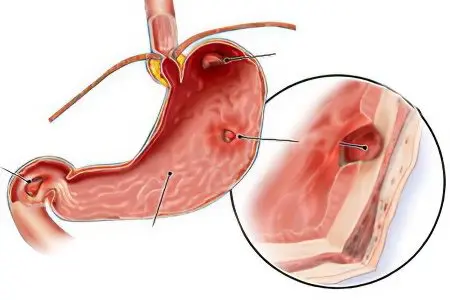
Polyps in the stomach are small raised growths on the surface of the mucous membrane. In their form, such neoplasms on short wide legs resemble small mushrooms, the size of which does not exceed three centimeters. All benign gastric polyps have a glandular structure. Most often they develop due to chronic gastritis and other inflammations. Gastric growths are divided into groups according to several criteria: clinical, pathological, radiological, etiological and pathogenic.
Polyps in the stomach can be:
In count – single, multiple and diffuse (more than 15 pieces);
By etiology – inflammatory, adenomatous, hyperplastic and neoplastic (prone to transition to a malignant form);
By structure – villous, tubular and mixed.
Gastric polyps are almost asymptomatic. They develop without discomfort and may be discovered incidentally on x-rays. In rare cases, patients complain of pain in the epigastric region. When the exit from the stomach is blocked, vomiting occurs. When a rather large polyp begins to manifest itself, there may be a taste of bitterness in the mouth, and there will be traces of blood in the feces and vomit. With serious pathologies, pallor, weakness and cramping pains cannot be avoided when the growths are pinched and enter the duodenum.
Causes such benign neoplasms can be in a hereditary factor, in chronic gastritis and other inflammations of the stomach. In addition, in people older than 50-55 years, the risk of developing gastric polyps increases significantly. It doesn’t matter what exactly caused such growths – in any case, they indicate malfunctions in the entire digestive system.
Treatment of any stomach polyps is based on systematic monitoring, a special diet and surgical resection. The necessary control should be carried out using endoscopic and radiological equipment. Accurate adherence to the prescribed diet will significantly slow down the development of an unfavorable process. The question of the need for surgical intervention is decided in each individual case, depending on the severity of the disease. The basic method of treatment in modern medicine is endoscopic polypectomy.
Polyps in the intestine

Polyps in the intestines are a serious danger. They grow on the walls of the intestine, blocking the lumen. Neoplasms such as hamartomatous polyps grow from the most common tissues of the mucous membrane. Juvenile growths are found in the colon, and adenomatous polyps are a typical facultative appendage. The subsequent degeneration of each type of intestinal pathology directly depends on the size and etiology of growth. The cause of the appearance of polyps in the intestines is considered only chronic inflammation.
Symptoms of the disease in patients with small polyps in the intestines are practically absent. Sometimes, in the presence of large villous adenomas, mucus impurities are noticeable in the patient’s feces. In severe cases, bleeding occurs. Large growths can mimic intestinal obstruction, which is accompanied by cramping pain. In addition, anal itching or prolonged constipation may begin. Due to the large loss of protein in large polyps in the intestine, a violation of homeostasis is often diagnosed.
Diagnostics such a dangerous pathology includes sigmoidoscopy and, if necessary, a digital examination of the rectum. The combination of diagnostic methods allows you to identify other related ailments.
Treatment of intestinal polyps, located on a thin stem, provides for standard loop electrocoagulation, which is carried out during colonoscopy. Outgrowths with a wide base are excised. Most benign neoplasms are easy to detect and remove with a modern colonoscope. All resected growths should be examined for the presence of malignant cells.
If the large size of the growths does not allow endoscopic removal, they are localized by surgical intervention. Abdominal surgery is also performed when removing malignant neoplasms. For resection of a polyp that has degenerated into an early cancerous tumor, modern endoscopic techniques are used, while it is necessary to take into account the individual characteristics of each specific growth.
After removal of polyps in the intestine It is necessary to regularly see a doctor to avoid recurrence of the disease. And after 50 years, every person is recommended to undergo annual preventive examinations of the intestine in order to detect cancerous tumors in the early stages.









